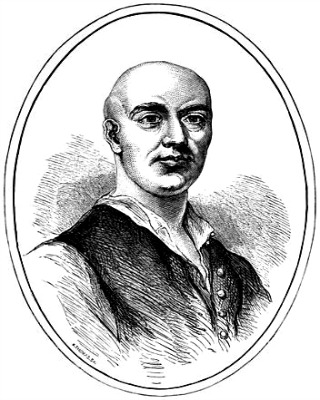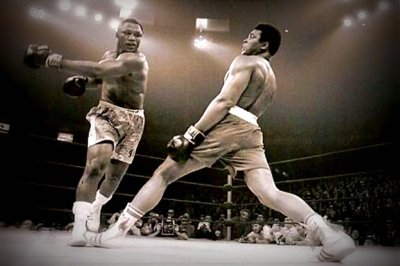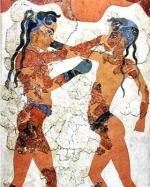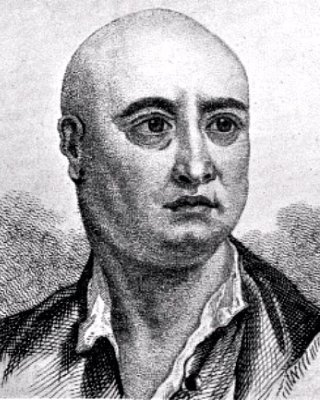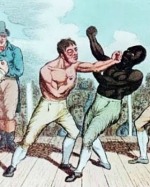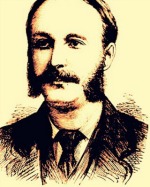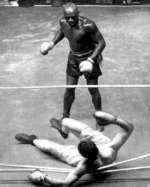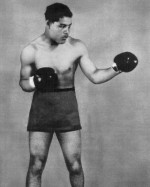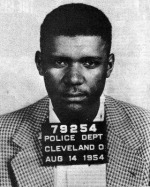The History of Boxing
What is Boxing?
Modern boxing rules are designed to facilitate a fighting contest between two people who try to either knock each other out or
win on points according to a set of rules, commonly called the Marquis of Queensbury Rules.
The fighters have to be of similar weights, are generally (though by no means always) fairly matched in terms of skill and use only punching techniques to hit their opponent.
They wear certain safety gear such as boxing gloves, groin guards and gum shields, sometimes headgear is also worn especially in non-professional fights.
The fighters have to be of similar weights, are generally (though by no means always) fairly matched in terms of skill and use only punching techniques to hit their opponent.
They wear certain safety gear such as boxing gloves, groin guards and gum shields, sometimes headgear is also worn especially in non-professional fights.
Talk the Talk
Boxing can also be called pugilism and a boxer referred to as a pugilist. This comes from the Latin word pugil meaning a boxer.
In ancient Rome, the boxing scene provided a common spectator sport until eventually in around 400 CE, the Roman establishment, who by this time had adopted Christianity, abolished it as it was seen as a particularly brutal activity.
Professional vs. Amateur Boxing
Modern boxing rules are geared towards both the entertainment of the crowd and the safety of the fighters, as far as a combat sport will allow where two people engage in a contest of strength, skill and cunning. It is an intense sport where two opponents throw punches at each other with gloves and is controlled by a referee, who officiates a series of one to three-minute rounds depending on if they are professional or amateur fights.In professional boxing matches rounds can last up to three minutes long and the bouts can last anywhere between four to thirteen rounds. The main objective in a professional match is to win each round or get a knockout. If a boxer knocks his opponent down or hits him hard enough for the referee to instigate a ‘standing count’, he rarely loses the round.
In amateur boxing, the bouts are usually around three to four rounds long with each round only lasting up to two minutes. Amateur boxing can be found at events like the Olympic Games and the Commonwealth Games, and the main objective is to win by points by landing more scoring shots on the opponent's target area or hitting an opponent hard enough to render him or her unable to continue fighting.
The Seventeenth-Century Boxing Revival
Although fist fighting for the sake of sport or entertainment undoubtedly took place throughout history, there was no real coherence or connection between bouts or fighters after boxing was banned by the Romans. However, the history of boxing took a turn in the seventeenth century when the sport saw a major revival in London. By the 1680s, matches had started to become common in Britain’s capital city and by the turn of the century, scheduled fights were taking place at the Royal Theatre. Some of the best fighters on the boxing scene at the time would tour the country in ‘boxing booths’, where they would challenge anyone to go a set number of rounds with them for the entertainment of the crowd and a cash reward for the few who could manage it.When not fighting in boxing booths, prize fighters would go up against each other in bare-knuckle fights that would have an unlimited number of rounds and would continue until someone was knocked out or unable to go on. Very little skill would usually be involved in these early stages of modern boxing history, though this changed over time as boxers came along who found ways to use tactics and brain power to overcome bigger and stronger opponents.
In the mid-eighteenth century, John ‘Jack’ Broughton (pictured above) became known as the Father of English Boxing after he introduced one of the first coherent sets of modern boxing rules. They were mainly concerned with the safety of the fighters and included banning hitting a man when he was down and low punches; he also introduced helmets and boxing gloves filled with horse hair, though these were just used for training purposes.
Boxing Rules in the Modern Era
Broughton’s rules would be the only real regulation the sport had for around one hundred years until in the nineteenth century, the sport developed further with the introduction of the Marquis of Queensbury Rules. Boxing gloves worn within the fights, three-minute rounds, the ten-second count and a ban on wrestling moves were all introduced making boxing recognisable as the sport that we know today.Towards the start of the twentieth century, America began to take an interest in boxing and Britain’s stranglehold on the world titles began to wane. Since then, new weights, rules, safety guidelines and boxing commissions have gradually been introduced and today boxing is recognised as one of the most popular sports on the planet, bringing in hundreds of millions of dollars each year and entertaining countless people in the process.
Every second in the boxing ring is important to the fighters, not only for the belts, medals, or titles they are competing for but also for the honour and passion of the sport. If you are also looking for good medals for your boxing club, be it for competition or as collectables, you can get bespoke medals on GS-JJ.com at an affordable price.
Kent, G. 2009. The Little Book of Boxing. The History Press. Gloucestershire.
Poliakoff, M. [Internet]. 2013. Boxing. Britannica. Available from: http://www.britannica.com/EBchecked/topic/76377/boxing [Accessed April 12, 2013].
The Ancient Olympics: Bridging past and present. [Internet]. 2013. The Open University. Available from: http://www.open.edu/openlearn/body-mind/health/sport-and-fitness/the-ancient-olympics-bridging-past-and-present/content-section-8.2 [Accessed April 12, 2013].
Written by Andrew Griffiths – Last updated 07/06/2023. If you like
what you see, consider following the History of Fighting on social media.
Further Reading:
Holland, G. [Internet]. 2008. History of London Boxing. The BBC. Available from: http://www.bbc.co.uk/london/content/articles/2007/11/13/early_boxing_history_feature.shtml [Accessed April 12, 2013].Kent, G. 2009. The Little Book of Boxing. The History Press. Gloucestershire.
Poliakoff, M. [Internet]. 2013. Boxing. Britannica. Available from: http://www.britannica.com/EBchecked/topic/76377/boxing [Accessed April 12, 2013].
The Ancient Olympics: Bridging past and present. [Internet]. 2013. The Open University. Available from: http://www.open.edu/openlearn/body-mind/health/sport-and-fitness/the-ancient-olympics-bridging-past-and-present/content-section-8.2 [Accessed April 12, 2013].
More Boxing History
Boxing in the Ancient World
Ancient boxing dates back to the Samarian culture and probably beyond and is known to have also been a part of the Egyptians and Minoan civilisations. It became an event in the ancient Olympic games in Greece in 688 BCE, and ancient Roman boxing was also practiced by athletes, gladiators and Roman soldiers.
Ancient boxing dates back to the Samarian culture and probably beyond and is known to have also been a part of the Egyptians and Minoan civilisations. It became an event in the ancient Olympic games in Greece in 688 BCE, and ancient Roman boxing was also practiced by athletes, gladiators and Roman soldiers.
Boxing in the 18th Century
Modern boxing history really began to develop into the sport known and loved today in the 18th century. Bare knuckled boxing contests began to be regulated and safety measures also began to be put in place. However, the period was also marred by controversy as it saw the first instances of corruption in the form of prize fighters taking payoffs and intentionally losing fights.
Modern boxing history really began to develop into the sport known and loved today in the 18th century. Bare knuckled boxing contests began to be regulated and safety measures also began to be put in place. However, the period was also marred by controversy as it saw the first instances of corruption in the form of prize fighters taking payoffs and intentionally losing fights.
Boxing in the 19th Century
This list of bare-knuckle boxers from the 19th century charts those who are generally accept as being World Champions. It includes some of the best fighters from this period in boxing history starting with Jem Belcher, the first champ of the new century and concluding with Jem Mace, who made the switch from bare-knuckle boxing to using boxing gloves after the introduction of the Queensbury Rules.
This list of bare-knuckle boxers from the 19th century charts those who are generally accept as being World Champions. It includes some of the best fighters from this period in boxing history starting with Jem Belcher, the first champ of the new century and concluding with Jem Mace, who made the switch from bare-knuckle boxing to using boxing gloves after the introduction of the Queensbury Rules.
Post-Queensbury Rules Boxing Culture
With the introduction of the Queensbury Rules in 1867, boxing culture was dramatically changed. The safety of the boxers was much improved though bare-knuckle boxing was still popular and as brutal as ever. For black boxers however, things actually changed for the worse as it became increasingly difficult for many of them to reach their full potential as a result of institutional racism.
With the introduction of the Queensbury Rules in 1867, boxing culture was dramatically changed. The safety of the boxers was much improved though bare-knuckle boxing was still popular and as brutal as ever. For black boxers however, things actually changed for the worse as it became increasingly difficult for many of them to reach their full potential as a result of institutional racism.
Sam Langford
Sam Langford, aka the Boston Tar Baby, was one of the greatest boxers never to be crowned world champion. Fighting in the early half of the twentieth century, he was a victim of the colour line in boxing and was not afforded a chance at the title because of the colour of his skin despite the fact that the champion at the time, Jack Johnson, was an African American.
Sam Langford, aka the Boston Tar Baby, was one of the greatest boxers never to be crowned world champion. Fighting in the early half of the twentieth century, he was a victim of the colour line in boxing and was not afforded a chance at the title because of the colour of his skin despite the fact that the champion at the time, Jack Johnson, was an African American.
Joe Louis
Joe Louis (The Brown Bomber) was an American boxer and widely considered to be one of the greatest world heavyweight champions of all time. He became an American hero when he defeated the German Max Schmeling, then later through his work promoting the war effort. Despite his considerable success, later in his career he would face massive debts due to unfair treatment by the taxman.....
Little Known Facts About Muhammad Ali
Muhammad Ali was a three-time heavyweight boxing champion and is widely regarded as the greatest boxer of all time, as well as one of the most influential sportsmen of the 20th century. This selection of little-known facts about ‘the Louisville Lip’ show he led an interesting and varied life, both inside and outside the ring.
Muhammad Ali was a three-time heavyweight boxing champion and is widely regarded as the greatest boxer of all time, as well as one of the most influential sportsmen of the 20th century. This selection of little-known facts about ‘the Louisville Lip’ show he led an interesting and varied life, both inside and outside the ring.
The Reign of Don King
Don King is an influential American boxing promoter who has staged some of the biggest fights in boxing history, increased the prize money earned by fighters and considerably raised public interest in the sport, all in his own charismatic and outspoken style. Despite this, King’s career has been constantly marred by controversy leading to him being both loved and hated in the world of boxing.
Don King is an influential American boxing promoter who has staged some of the biggest fights in boxing history, increased the prize money earned by fighters and considerably raised public interest in the sport, all in his own charismatic and outspoken style. Despite this, King’s career has been constantly marred by controversy leading to him being both loved and hated in the world of boxing.
The images on this site are believed to be in the public domain, however, if any mistakes have been made and your copyright or intellectual rights have been breeched, please contact andrew@articlesonhistory.com.

